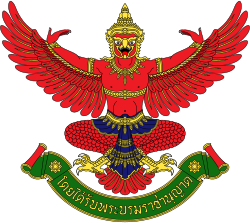Emblem of Thailand
|
|
|---|---|
 |
|
| Versions | |

Variant with broader wings (displayed by a firm bearing a Royal warrant)
|
|
| Details | |
| Armiger | Maha Vajiralongkorn (Rama X) |
| Adopted | Officially in 1911, replacing the coat of arms of Siam from 1873. Originally adopted during the Ayutthaya period. |
| Use | Used by the monarchy and government of Thailand on all official documents. |
|
|
|---|---|
 |
|
| Details | |
| Armiger | Chulalongkorn (Rama V) |
| Adopted | Created in 1873, discontinued in 1910. |
| Use | Used by the king and the government of Siam on all official documents. |
The national emblem of Thailand (Thai: ตราแผ่นดินของไทย) is called the Phra Khrut Pha (RTGS transcription; พระครุฑพ่าห์; "Garuda as the vehicle" (of Vishnu)). The Garuda was officially adopted as the national emblem by King Vajiravudh (Rama VI) in 1911. However, the mythical creature had been used as a symbol of royalty in Thailand for centuries. The Garuda is depicted on seals, which are used by the King of Thailand and the Government of Thailand to authenticate official documents and as its primary emblem.
The Garuda is a mythological beast of the Hindu and Buddhist tradition. According to Hindu mythology, the Garuda is the vahana (vehicle) of the god Vishnu (more commonly known in Thailand as Narayana). The ancient kings of Thailand believed in divine kingship, and considered themselves the incarnation of the god Narayana. Thus, the Garuda came to symbolise the divine power and authority of the king.
The Garuda also features in the national emblem of Indonesia and the emblem of the city of Ulaanbaatar (the capital of Mongolia).
The Garuda is a birdlike mythological beast of the Hindu and Buddhist tradition. According to mythology, the Garuda is a large hybrid half-man and half-bird creature. The Garuda is often depicted in art as having the head, beak, wings and talons of an eagle, while his torso is like that of a human man. In the book Traiphum Phra Ruang, a Thai Buddhist literary work composed in the 14th century, he is described as having a body that was 150 yojanas across (1 yojana equivalent to 1.6 kilometres), his left and right wings 150 yojanas each, his tail 60 yojanas long, his neck 30 yojanas, his beak 90 yojanas and his talons 12 yojanas each.
...
Wikipedia
